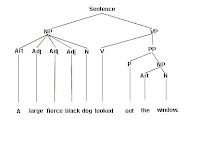hi...
click>>>Deal good stuff
An example of ambiguity:
I promise I'll give you a ring tomorrow. <<<(not me ...hahahaha)
Although uncommon in American dialects, "giving someone a ring" can simply mean calling them on the telephone. But, obviously, the above sentence can also mean giving someone a piece of jewelry worn on the finger. The statement is, therefore, ambiguous.
thanks to MR.WIKI
Phrase structure rules
From Wikipedia, the free encyclopedia
Phrase-structure rules are a way to describe a given language's syntax.
They are used to break down a natural language sentence into its constituent parts
(also known as syntactic categories) namely phrasal categories and lexical categories
(aka parts of speech). Phrasal categories include the noun phrase, verb phrase, and prepositional phrase;
lexical categories include noun, verb, adjective, adverb, and many others.
Phrase structure rules were commonly used in transformational grammar (TGG),
although they were not an invention of TGG; rather, early TGG's added to phrase structure rules
(the most obvious example being transformations; see the page transformational grammar for an
overview of the development of TGG.) A grammar which uses phrase structure rules is
called a phrase structure grammar - except in computer science, where it is known as
just a grammar, usually context-free.
They are used to break down a natural language sentence into its constituent parts
(also known as syntactic categories) namely phrasal categories and lexical categories
(aka parts of speech). Phrasal categories include the noun phrase, verb phrase, and prepositional phrase;
lexical categories include noun, verb, adjective, adverb, and many others.
Phrase structure rules were commonly used in transformational grammar (TGG),
although they were not an invention of TGG; rather, early TGG's added to phrase structure rules
(the most obvious example being transformations; see the page transformational grammar for an
overview of the development of TGG.) A grammar which uses phrase structure rules is
called a phrase structure grammar - except in computer science, where it is known as
just a grammar, usually context-free.
[edit]Definition
Phrase structure rules are usually of the form  , meaning that the constituent A
, meaning that the constituent A
is separated into the two subconstituents B and C.
is separated into the two subconstituents B and C.
Some examples correct inter alia for natural English language are:
The first rule reads: An S consists of an NP followed by a VP. This means A sentence
consists of a noun phrase followed by a verb phrase. The next one: A noun phrase consists
of a determiner followed by a noun.
consists of a noun phrase followed by a verb phrase. The next one: A noun phrase consists
of a determiner followed by a noun.
Associated with phrase structure rules is a famous example of a grammatically
correct sentence. The sentence was constructed by Noam Chomsky as an illustration
that syntactically but not semantically correct sentences are possible.
correct sentence. The sentence was constructed by Noam Chomsky as an illustration
that syntactically but not semantically correct sentences are possible.
Colorless green ideas sleep furiously can be diagrammed as a phrase tree, as below:
where S represents a grammatical sentence. The theory of antisymmetry proposed in
the early '90s by Richard Kayne is an attempt to derive phrase structure from a single axiom.
A phrase tree can be represented by a ultrametric, see Mark D. Roberts http://arXiv.org/abs/cs.CL/9810012.
the early '90s by Richard Kayne is an attempt to derive phrase structure from a single axiom.
A phrase tree can be represented by a ultrametric, see Mark D. Roberts http://arXiv.org/abs/cs.CL/9810012.
- brief explanation here>>>>> http://en.wikipedia.org/wiki/Phrase_structure_rules
see more >>>>THE COOL NOTE~ explaination
The examples of tree diagrams.
p/s:ok ,done for this time being.......





nak chat senag je....taip je kat tulis relevant respon tu...dah tunggu apa? tulis cepatt....haaaiiiippp!!
ReplyDelete